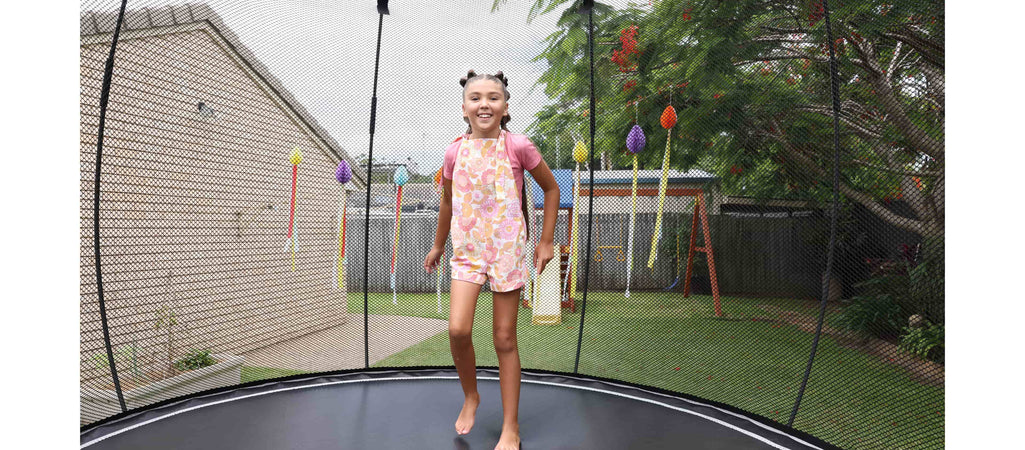In Ground Trampoline vs. Springfree | A Fair Comparison
The ultimate showdown: in-ground trampoline vs. Springfree! Discover which wins in safety, quality, installation and total cost in this fair analysis.
min read

Today, we’re going to settle the in-ground trampoline vs. Springfree debate once and for all.
This honest and unbiased comparison will include insights into:
- How in-ground trampolines compare to Springfree in safety, quality and durability.
- How in-ground trampolines compare to Springfree on installation (IMPORTANT).
- How in-ground trampolines compare to Springfree on total costs.
By reading this, you will be able to answer whether an in-ground trampoline or a Springfree Trampoline is the right choice.
In-Ground Trampoline vs. Springfree Comparison
We are going to be comparing in-ground trampolines to Springfree Trampolines on the following factors:
- Trampoline Safety
- Trampoline Quality/Longevity
- Trampoline Aesthetics
- Trampoline Installation
- Trampoline Cost
Make sure to pay attention to the two factors, as these will likely make or break your decision!
Let’s dive into each in more detail.
1. Trampoline Safety
Springfree Trampolines are safer than in-ground trampolines.
But in-ground trampolines are safer than most other above-ground trampolines.
What makes Springfree different than other above-ground trampolines?
The difference lies in their product design, which includes:
- Composite rods that replace the metal springs – the springs/frame make up 20% of all injuries on trampolines.
- A net that flexes when a person jumps into the net, helping to prevent falling injuries.
- A frame that is hidden underneath the jumping surface and out of harm’s way.
- A mat that is 30x more shock absorbent than traditional trampolines and includes no hard edges.
- Flexible net rods that replace hard metal poles, which can cause injury.
A Springfree Trampoline:

These safety features are why Springfree Trampolines eliminate 90% of product-related injuries. It’s also why they are safer than in-ground trampolines.
In-ground trampolines are safer than your typical trampoline, though.
Because they are ground level, they eliminate the chances of falling off the trampoline. They are also easier to access.
An in-ground trampoline, courtesy of Capital Play.

However, they still include a metal frame and springs, which can cause painful injuries if the padding starts to wear down.
Many in-ground trampolines also don’t include enclosure nets (although they are available). This opens you up to potential safety hazards if your trampoline is next to rocks or concrete.
Winner: Springfree
2. Trampoline Quality/Longevity
This is another case of where in-ground trampolines lose when they would normally win.
In-ground trampolines should last longer than most traditional trampolines.
But Springfree’s aren’t traditional.
You can make the argument that since in-ground trampolines are buried, they won’t experience rust or sun-related damage on the metal frame or springs. They also won’t blow away in the wind.
On traditional trampolines, this would sway the argument to in-ground trampolines.
But Springfree Trampolines undergo a three-layer rust-proofing process. They also undergo extensive UV treatment on all relevant components.
Plus, they can survive winds like this:
Springfree Trampolines can safely last 10+ years without having to be taken down in inclement weather.
This is backed by an industry-leading 10-year trampoline warranty on ALL parts of the trampoline.
No other manufacturer covers all parts of the trampoline for the same warranty period.
Comparing Springfree’s warranty to Avyna’s, one of the premier makers of in-ground trampolines, demonstrates this.
In-Ground Trampoline vs. Springfree Warranty Comparison
The Avyna 10 ft x 17 ft Inground Trampoline:

On Avyna’s 10 ft x 17 ft Inground Trampoline, its warranty coverage is as follows:
- Lifetime on the trampoline frame (better than Springfree)
- 10 years on the springs (excellent coverage for springs)
- Three years on the padding and mat.
If you just take the frame and springs, Avyna’s Trampoline would be better.
However, the three years on the padding and mat hint that they will need to be replaced around the three-year mark.
You may have to change the padding and mat three times during the 10 years a Springfree Trampoline can last without changing any major parts.
Winner: Springfree
3. Trampoline Aesthetics
Aesthetics is such a difficult thing to grade because it’s so subjective.
Both Springfree Trampolines and in-ground trampolines can be stylish additions to a backyard.
Whichever one looks better depends on your point of view.
We will give the edge to in-ground trampolines because they don’t stick out as much. Since they are buried, in-ground trampolines can almost be “hidden.”

Photo courtesy of Trend Hunter.
For those who don’t want a big trampoline to be featured in your backyard, this can be appealing.
Winner: In-ground trampolines
4. Trampoline Installation
If you’re installing an in-ground trampoline, be prepared to pay thousands of dollars for installation. Not for the trampoline: for installation!
In-ground trampoline installation is tedious and time-consuming. At the basic level, you must:
- Dig a hole.
- Ensure it’s properly structured.
- Set up a proper drainage system.
Think of installing an in-ground trampoline like installing a swimming pool.
It doesn’t take as long (although it can last weeks), but the process is similar and likely requires professional assistance.

Photo via Trampoline Holes.
Another potential downside to installing an in-ground trampoline is it’s a permanent structure. Once it’s in the ground, it’s there to stay.
This can cause problems if you decide to change the landscaping of your backyard. It’s also an issue if you move houses.
Now, Springfree Trampolines are not a walk-in-the-park to assemble either.
Their unique design can make it challenging for the average person to install. Particularly, installing the mat rods might be difficult for some.
The Springfree Mat Rods:

But there are detailed resources (like 3D instructions courtesy of the BILT App) that you can lean on for assistance.
You can also hire professional installers for around $399 (depending on the area) to do it for you. It can be completed in 2-3 hours.
Even with the potential complexity of Springfree Trampoline’s installation, it’s nowhere near the commitment in time, space and money that in-ground trampolines require.
Winner: Springfree
5. Trampoline Cost
The total cost of owning an in-ground trampoline far exceeds that of a Springfree Trampoline.
For the trampoline itself, they are relatively similar. The most expensive Springfree model (the Jumbo Oval Trampoline) is $3,999.
On Trampolines.com, the most expensive in-ground trampoline is $5,695.
While in-ground trampolines can run more expensive, you will find most in-ground and Springfree models in the $1,000-$4,000 range.
But as you know from the last section, the cost of installing an inground trampoline can potentially be more than the trampoline itself.
For an inground trampoline kit and installation, you could be paying $5,000 or more.
While a Springfree is expensive upfront, the trampoline itself is the bulk of the cost. Even if you pay $399 for professional installation, you will still likely be in the $1,000-$3,900 range (depending on size).
Winner: Springfree
In-Ground Trampoline or Springfree?
In-ground trampolines have their unique advantages. They are discreet, easy to access and eliminate falling off the trampoline – a common cause of trampoline injury.
When it comes to overall safety, quality/longevity, installation and cost, Springfree is objectively better.
This doesn’t mean that a Springfree is always the right answer.
It’s situation-dependent, and some might prefer the look of an in-ground trampoline in their backyard.
There’s a reason why Springfree Trampolines are premium trampolines.
They are expensive upfront, but it’s because you’re getting the safest, highest-quality and longest-lasting trampoline.
An in-ground trampoline will likely cost more to install, and it doesn’t give you the same trampoline safety promises as Springfree.
If you’re spending thousands of dollars on a trampoline, you want to make sure you get your money’s worth.
Springfree would likely be a better and more realistic bet for most households.
Which Springfree Trampoline Is Right for You?
If you’re considering a Springfree Trampoline, you’re going to need to figure out which size you need.
We have a free Model Comparison Tool that will let you choose two springless trampoline sizes and compare key areas like jumping room and trampoline footprint.
It’ll look like this:

Check it out and reach out to us if you have any questions!


